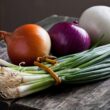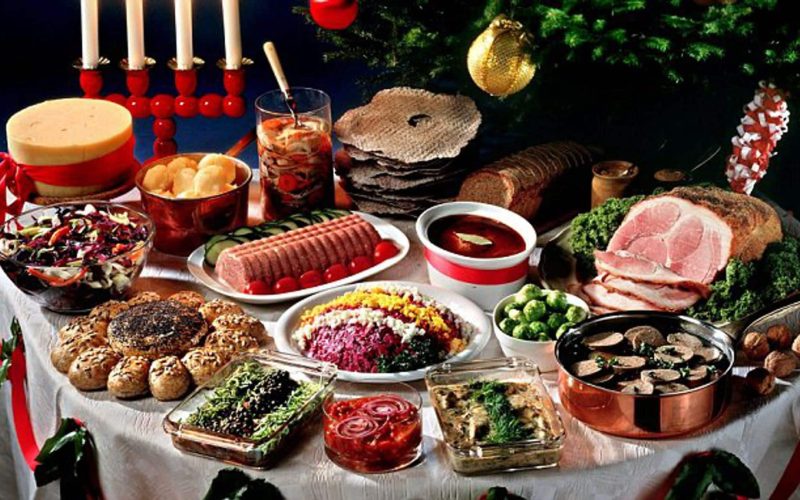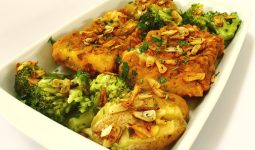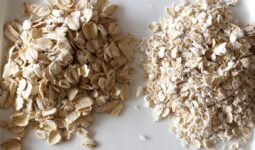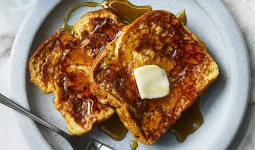At Christmas, various Swedish Christmas foods are available, including the Janssons frestelse or the Jansson’s Temptation (which originated in Gothenburg).
It’s traditionally eaten at Christmas lunch, along with other Swedish favorites like pytt panna (a meatball and mashed potato dish) and Gravad lax (a type of cured salmon).
Read on to learn more about other great traditional Swedish Christmas foods you can enjoy while celebrating this festive time of year.
1. Sylta
These classic Swedish Christmas foods of sylta are a popular holiday dish. It is made by boiling red cabbage in water until soft, then adding sugar and salt. It can be served either hot or cold.
Another popular holiday food is semlor, cream-filled pastries with cardamom sprinkled on top. These are often eaten on Shrove Tuesday and are called fastlagsbullar in Sweden.
They are sometimes topped with whipped cream, powdered sugar, and cinnamon.
2. Risgrynsgröt and Ris à la Malta
Risgrynsgröt, or rice porridge, is a traditional Swedish Christmas food. It is made by cooking rice in water and mixing it with milk and sugar until the rice grains are soft.
To make it more filling, you can add dried fruit, cinnamon, or almonds (you’ll need your strength for all that gift wrapping!).
It’s topped with whipped cream and served cold with a sprinkle of ground cardamom.
Rice pudding is similar to risgrynsgröt but usually contains more sugar and less water than risgrynsgröt. It can also be served as a side dish or dessert during the holiday season.
Ris à la Malta is another popular Swedish dish often served at Christmastime celebrations.
It consists of rice cooked in milk with cinnamon and almonds on top.
3. Rödbetssallad
Rödbetssallad is a classic dish served at many Swedish Christmastime celebrations. It consists of raw beets, celery, apples, and onions marinated in a vinaigrette dressing.
The dish is traditionally served with boiled potatoes and crème fraîche or mayonnaise.
Rödbetssallad is often considered an essential part of the Scandinavian Christmas table.
Some families make it as early as October and store it in the refrigerator for later use.
A good rule of thumb is to assemble rödbetssallad at least two days before serving it so that the flavors can meld.
You would carve These Swedish Christmas foods for a very long time!
4. Eel
Certainly not left out, Eel is traditional Swedish Christmas food. It is typically fried in butter or oil and served with mashed potatoes. The eels are gutted, skinned, and cut into pieces before frying.
Usually, they are served with a sauce of melted butter, salt, pepper, and chopped parsley. These can be placed on the side of the plate or poured over the eels.
5. Gingerbread, Tough Caramel, Butterscotch, and Christmas Chocolate
Gingerbread, Tough Caramel, Butterscotch, and Christmas Chocolate are some of the most famous on this Swedish Christmas foods list.
Gingerbread is a spiced biscuit that tastes like ginger, cinnamon, and cloves. It is often iced with white sugar icing or decorated with chocolate or marzipan.
Tough Caramel is caramelized sugar boiled until thick and syrupy. It can be flavored with vanilla or spices such as cinnamon, cardamom, or ginger.
Butterscotch is made by combining butter with brown sugar and boiling it for 10-15 minutes until it reaches the desired consistency.
Butterscotch is often flavored with vanilla extract or cream of tartar for added flavor and color.
6. Cabbage, Brussels Sprouts, and Kale
Cabbage, Brussels Sprouts, and Kale are considered special Swedish Christmas foods.
Cabbage is a relatively unknown vegetable in Sweden and has only been eaten since the 19th century.
Meanwhile, Brussels Sprouts were introduced in the 17th century and became popular after Queen Christina of Sweden planted them on her estate.
Kale was not eaten at all before the 16th century but has recently increased in popularity.
7. Swedish Meatballs
This dish is a must-have in most homes on Christmas Eve. It is an old-fashioned dish that most people think of as the quintessential Swedish Christmas food.
However, it has more Turkish origins and was introduced into Sweden by a meat-processing company in the 1950s.
Moreover, the recipe has many variations, but here is one simple version. The ingredients are butter, chopped onion, all-purpose flour, beef broth, milk, ground beef, salt and pepper, finely chopped fresh parsley leaves, egg yolk, nutmeg, and bread crumbs.
Directions for making: First, melt the butter in a large skillet over medium heat. Then, add the onion and cook until soft.
8. Janssons Frestelse
Janssons frestelse is a dish that consists of potatoes and onion fried in butter. It is served with salt, pepper, and allspice on the side. The potatoes are then puréed until they are smooth.
It’s typically served as part of a smorgasbord during the holidays, often with two kinds of mustard: sweet and spicy.
The potatoes are boiled in a pot with water and salt until they’re soft enough to mash.
They’re then mashed with butter, onions, heavy cream, dill, nutmeg, and white pepper. The mixture is brought back to a boil and served piping hot.
These Swedish Christmas foods are traditionally made with smoked ham or bacon. However, vegetarian versions can be made using portobello mushrooms as a meat substitute. Jansson frestelse is often served with rice pudding or vanilla ice cream for dessert.
9. Janssons
The most well-known Swedish Christmas food is the Janssons. Its ingredients are brown onion, butter, anchovy filets, hard-boiled eggs, and potatoes.
The dish is simmered in a frying pan until the vegetables have caramelized and become dark brown, not burnt.
Then, the eggs are peeled and chopped into small pieces. These are fried together with the anchovies before adding them to the vegetables.
Seasoning with salt and pepper is left until the dish has cooled before serving.
10. Lussekatter
Lussekatter (or Lucia Cats) is a type of sweet pastry eaten during the holiday season in Sweden.
They are typically served for breakfast on December 13th, Saint Lucy’s Day. They may also be served with coffee or tea as an afternoon snack.
Meanwhile, the tradition of eating Lussekatter on December 13th goes back at least to 1850, when the writer Carl Michael Bellman popularized it.
These Swedish Christmas foods are made from a dough consisting mainly of butter and sugar, flavored with cardamom and cinnamon.
Then, it is filled with almond paste or another filling of your choice. Once shaped into the desired form, it is usually sprinkled with icing sugar. Finally, it is baked in the oven until it turns golden brown.
11. Sillbord
Speaking about the Swedish Christmas foods roll, Sillbord is a big part of the Scandinavian tradition.
It’s a buffet-style smorgasbord with a selection of different dishes. For example, pickled herring, cured meat, ham, and smoked fish.
Typically, the food is served on platters with slices of bread or crackers for dipping.
The food is usually eaten with your hands, but you can also use a knife and fork if you prefer.
12. Salmon
Salmon is a popular Swedish Christmas food. Traditionally, it is served with mashed potatoes, cream sauce, and green peas.
This dish can be prepared as an entrée or the main course. For variety, salmon may also be served with dill sauce, hollandaise sauce, or red wine sauce.
13. Glögg and Julmust
Glögg, sometimes called gløgg in Scandinavia, is a warm wine-based beverage flavored with spices such as cardamom and ginger. It is usually served with almonds and raisins for added flavor.
While traditionally drunk during Christmas, it can be enjoyed all year round. Julmust is a soft drink flavored with orange peel, cinnamon, cloves, and gingerbread cookies.
14. Prinskorv
Like other Swedish Christmas foods, Prinskorv is a popular dish during the holiday season in Sweden.
The sausage is ground meat seasoned with pepper, allspice, and nutmeg.
Usually, it is prepared in the shape of a coil and then fried or roasted. The coil can also be boiled or baked.
Prinskorv is typically served with mashed potatoes and lingonberry jam for breakfast on December 24th and mustard for lunch on December 25th.
15. Christmas Ham
Christmas ham is a typical Swedish dish served at Christmas dinners. It’s made of pork, traditionally cured with salt and sugar and smoked over beech wood.
These Swedish Christmas foods are boiled for about three hours before being roasted in the oven. They usually reach an internal temperature of 75 degrees Celsius (167 degrees Fahrenheit).
Once cooked, it’s glazed with a sugar and vinegar mixture before cooling.
16. Pork Ribs
Revbensspjäll is a classic Swedish dish that is served as one of the main dishes during the holiday season.
Revbensspjäll, translated literally as ribs roast, is traditionally made with pork ribs, potatoes, carrots, and onions.
Furthermore, the meat can be coated in flour or breadcrumbs before being fried in butter until golden brown.
To make this dish even more delicious, we recommend adding some applesauce to the saucepan for an extra kick of sweetness.
As always, there’s more to come on this Swedish Christmas food list.
17. Cod
Cod, or lutefisk, is a dish traditionally served during the holidays in Sweden.
It is typically served with potatoes, pickled beets, and a cream sauce and can be eaten hot or cold.
Additionally, Lutefisk has a gelatinous texture that people either love or hate.
Swedish Christmas foods originated from Norway and were brought to Sweden by Norwegian immigrants around 1850.
18. Toffee
There are many different ways to celebrate Christmas in Sweden. One of the most popular is by eating a lot of different sweets.
Every year, Swedes eagerly await December 25th, when they can indulge in all the confectionary goodies.
These goodies have been lovingly prepared in the weeks leading up to the big day.
Important to note, Toffee is one of these goodies you would want to take advantage of.
Toffee is one of the sweets regarded as a special Swedish Christmas food!
19. Candy Canes
Candy canes are not typically associated with Sweden, but there is a story about why they are served on the holiday table.
Legend has it that in 1693, the King of Sweden ordered red and white striped candy canes to be made in honor of his new wife’s wedding gown; what an unusual way to come up with what ended up being Swedish Christmas foods.
Furthermore, in 1747, the first hard candies were made by accident when a pot of sugar was left unattended on a stove.
The heat caused the sugar syrup to crystallize into hard candy, which we now know as rock candy. Rock candy is often wrapped around a stick and dipped in chocolate for more enjoyment.
